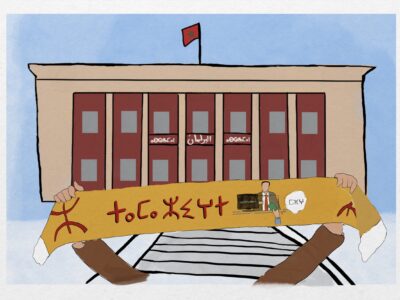Shaghayegh Azimi is the epitome of what is often referred to on Global Voices as a “bridge-blogger”; that is, someone who uses their weblog to bridge two or more cultures. There is only one catch – Azimi isn't really a blogger. As a former film producer in Iran, video has always been her preferred medium of expression. And she's not alone. In an interview over Skype, Azimi says that thousands of Iranian youth yearn to become filmmakers, but that limited access to equipment, along with Iran's few channels of distribution, mean that only the very best, luckiest, or most well-connected are able to share their creative works with a national audience. At Iran's Short Film Festival, only a select few of the hundreds of submissions by aspiring filmmakers are shown. What about all the others? I asked Azimi.
“They're never seen outside a small group of friends and family.”
All across the world, the rules of filmmaking – especially documentary filmmaking – are changing. What used to require outlandishly expensive audio, video, and editing equipment is now possible with a laptop computer and thousand dollar video camera. In addition to changes in production, new methods of distribution have also lowered the barriers to entry for up-and-coming filmmakers. The success of internet shows like Ask a Ninja, Rocketboom, and Alive in Baghdad show that video isn't just the future of the internet – it's already here.
So if hundreds of mostly young Iranian filmmakers are already using video to show the reality of Iran as they see it, and if millions of broadband-connected youth around the world are scouring the internet for new video, then why have those two groups not yet found each other?
Probably because they've never been introduced. Which is where Shaghayegh Azimi is now playing such an important role. With the help of a Rising Voices microgrant, she will explain to Iranian filmmakers how they can use videoblogs to distribute their short films and documentaries to an international audience. Once the videos are available online, Azimi will also see to it that they are sub-titled in English (and other languages) and distributed widely via popular video-sharing networks.
Iran Inside Out is a window of moving images that will allow those living outside the country to point their video cameras and share their lives with the rest of the world. On her project blog, Shaghayegh describes some of what we can soon look forward to, including a snapshot of the underground heavy metal scene in Iran and a personal reflection of what a US-Iran war would mean to the life of a single filmmaker.
Shaghayegh herself grew up an equal amount of time in both the United States and Iran and says she spent a good deal of her formative years defending each of her two homes to the residents of the other. The major difference, she notes, is that while nearly all Iranians are informed about the latest cultural and political developments in the United States, many Americans can't even locate Iran on a map.
The internet is a global village, but only if we choose for it to be. Shaghayegh Azimi is holding her hand out, waiting to introduce you to some new neighbors. Why not take the initiative and introduce yourself?




5 comments
My goodness, that trailer is sooo good. I can’t wait to see more.
Looks Amazing, I can’t wait to see the entire thing…Good Job :)
=))